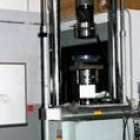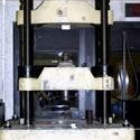Loading & Bearing Machines
SEESL is equipped with multiple loading fixtures and bearing machines to test specimens of various sizes, load, and scope. All test specimens can be instrumented with a variety of sensors for data acquisition. Further information on what instrumentation is available can be found on our Instrumentation page.
Large Bearing Machine
The Large Bearing Testing Machine has been developed and primarily used for commercial testing of large bearings. It is capable of applying 1,600 kips (7,117 kN) vertical load, and lateral displacement of ±5 in. (125 mm) amplitude and 10 in/sec (255 mm/sec) peak velocity. This machine is controlled with a MTS actuator using manufacturer-supplied controller software.
Small Bearing Machine
The Small Bearing Testing Machine is a highly versatile machine that is capable of applying simultaneous compression or tension, shear and rotation on specimens. It has a 50 kip (223 kN) vertical load capacity (but expandable if a higher capacity load cell is used), ±6 in. (150 mm) horizontal displacement capacity, ±2 degrees rotational capacity and peak speed of over 20 in./sec (0.5 m/sec). Similarly to the large bearing machine, this is also controlled with MTS actuators and controller software.
Axial-Torsion Machine
This machine is capable of biaxial testing of specimens and components of many sizes, up to 4 ft. (1.22 m) in length. Control modes available are force, strain and displacement in axial mode, and torque (in/lb.), strain and rotation (degrees) in torsion mode. The machine has calibrated ranges of 100, 50, 20, and 10 kips, and ± 5, 2.5, 1, and 0.5 in. axially, as well as 50000, 25000, 10000, and 5000 pounds-inch, and 50, 25, 10, and 5 degrees in the torsion mode.
Tinius Olsen Universal Testing Machine
The Tinius Olsen machine has been used primarily for testing concrete cylinders, structural steel members, and standard steel test specimens. The machine consists of a dual crosshead, mechanical screw load frame, with a test surface platen having an effective area of 31 in. (79 cm) x 43 in. (109 cm). The platen is 45 in. (114.3) from the lab floor. The crossheads can be placed at any height along the screws to allow testing of specimens up to 72 in. (183 cm) long in tension. The upper crosshead is locked in place during testing, while the lower crosshead moves along the machine's screws to apply tension or compression to the specimen. Compression testing capacity is limited by the tendency of tall specimens to buckle, but theoretically a 72 inch (183 cm) specimen can also be tested in compression. The machine is capable of testing specimens in tension or compression to 300 kips (1334 kN). Force readout is provided by a dial indicator calibrated in ranges of 3, 12, 60 and 300 kips (13. 53, 267, and 1334 kN). For electronic readout, any suitable load cell can be mounted in series with the test specimen. Alternatively, a Temposonic displacement transducer is mounted on the gear rack assembly which drives the dial indicator, providing a linear voltage readout proportional to the position (force readout) of the dial indicator. Displacement readout is accomplished by using displacement transducers of suitable range mounted parallel to (or directly on) the test specimen.
Universiety Research Request Form
For testing being done within within the University at Buffalo, faculty and students please use the below form to request time for using any of the above machines. To those outside of the University at Buffalo, please use our contact us form to talk with our Structural Test Engineer for scheduling and quotes.



